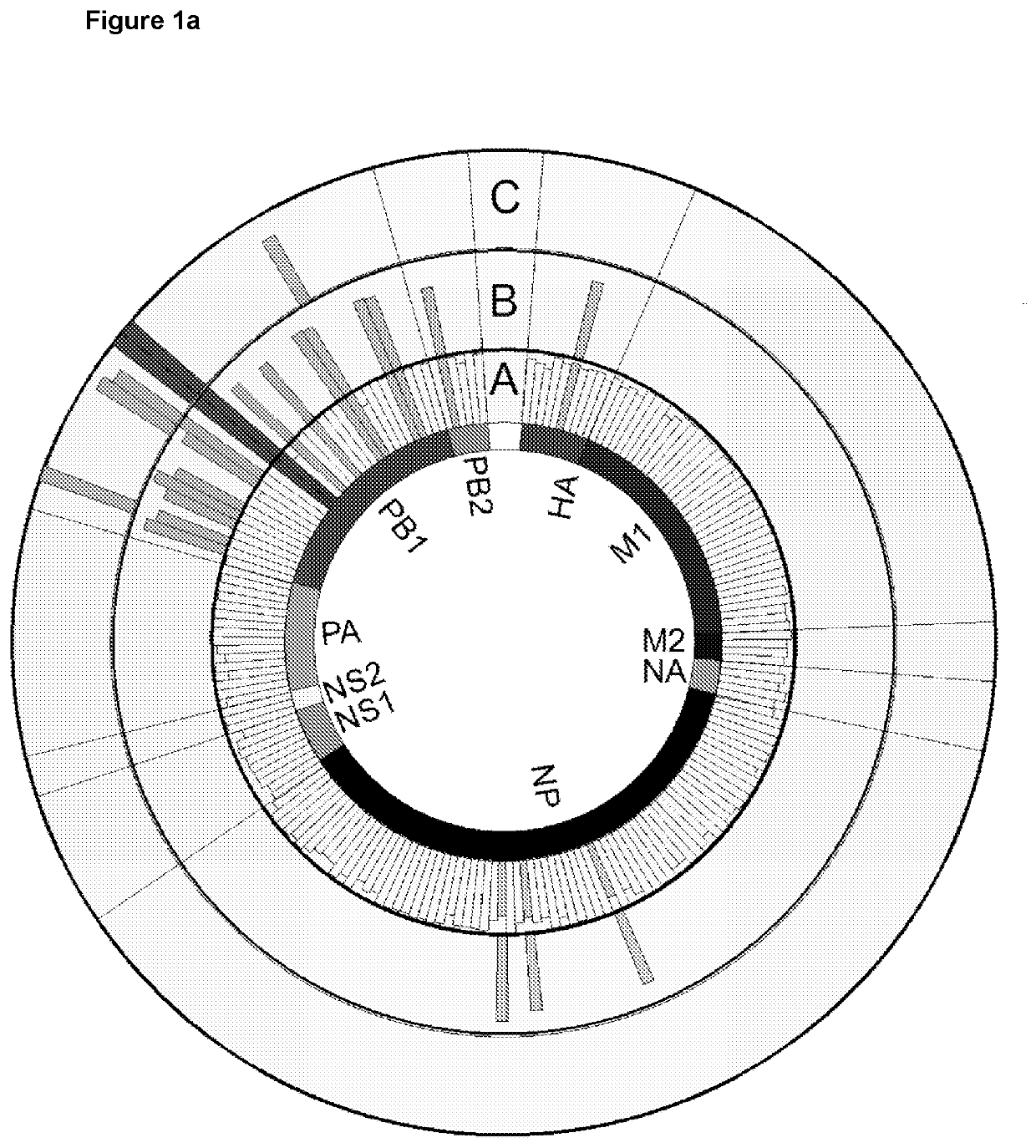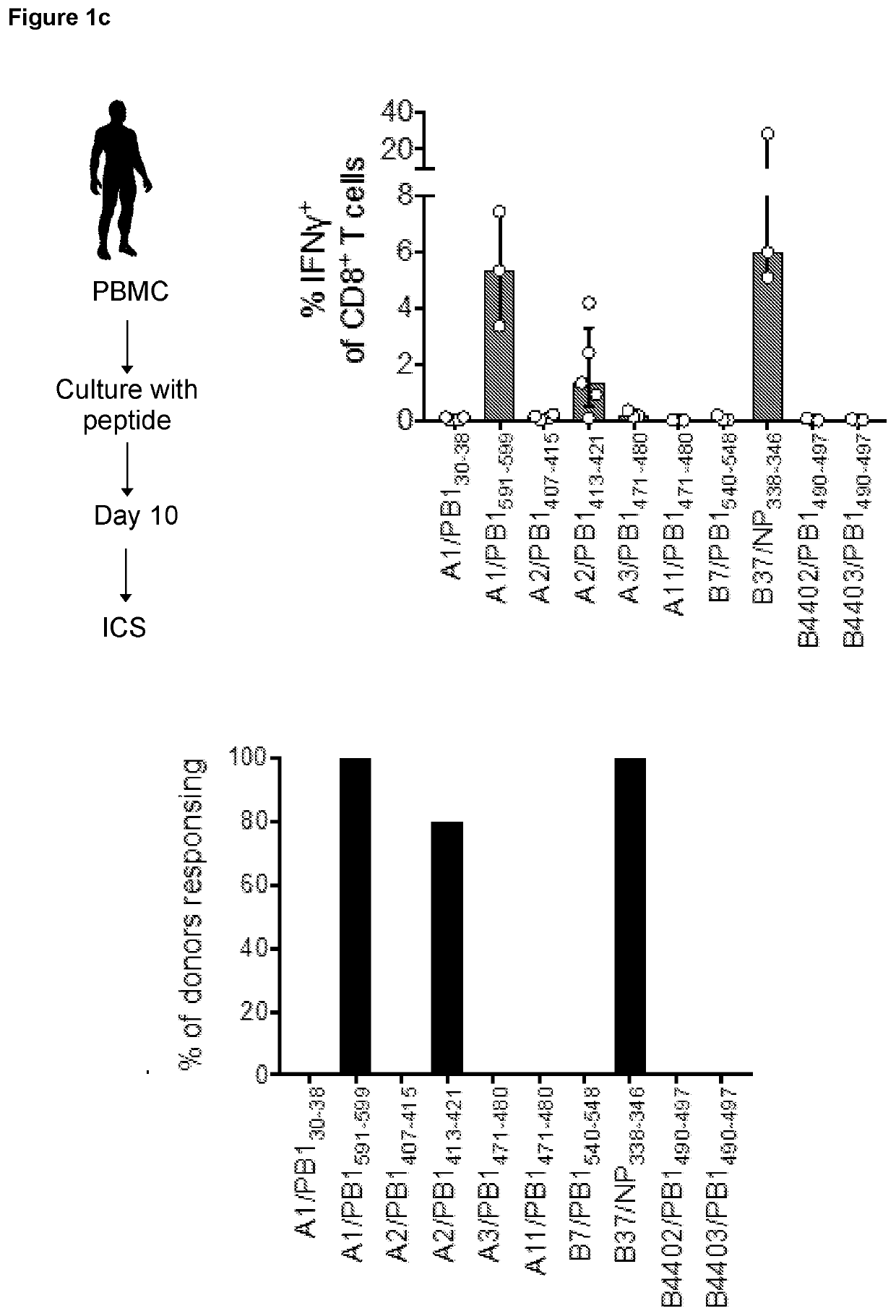Methods and compositions for preventing influenza infection
a technology of compositions and methods, applied in the direction of immunological disorders, antibody medical ingredients, peptide sources, etc., can solve the problems of vaccines currently utilised, influenza remains a major cause of mortality and morbidity,
- Summary
- Abstract
- Description
- Claims
- Application Information
AI Technical Summary
Benefits of technology
Problems solved by technology
Method used
Image
Examples
example 1
ctivity Across Influenza A, B and C
[0239]The conservation of known Influenza A (IAV) CD8+ T cell epitopes was determined across Influenza B (IBV) and Influenza C (ICV). This analysis enabled identification of a set of well conserved epitopes across the three types of influenza (FIG. 1a).
[0240]The high conservation of the PB1413-421 peptide, along with the high prevalence of HLA-A2 in the human population prompted further characterization of responses to this epitope. PB1413-421 was determined to be conserved across IAV, IBV and ICV, as well as IDV although a substitution (L7F) present in IDV isolated (FIG. 1b). Importantly, this peptide was found to be 100% conserved in 99.86% of influenza A, B or C viruses (n=39182 sequences).
[0241]Conservation analysis of >67,000 influenza segment sequences identified 31 conserved epitopes (with >70% amino acid identity) across IAV and IBV as well as 8 epitopes across all IAV, IBV and ICV influenza types. Based on the prevalence of HLA-restricting...
example 2
ation of IAV- and IBV-Derived Epitopes by Immunopeptidomics
[0246]Methods: Immunopeptidome Analysis.
[0247]To identify peptides naturally presented by HLA-A*02:01 and HLA-A*A24:02 on the surface of infected cells, an immunopeptidomics approach was employed.
[0248]Class-I reduced (C1R) lymphoblastoid cell lines expressing HLA*A2:01 or HLA-A*24:02 were used. 109 cells were infected with influenza A (X31) or influenza B (B / Malaysia) at a multiplicity of infection (moi) of 4 and cells were incubated for 12 hours. At 12 hours, cells were harvested and snap-frozen in LN2.
[0249]Cell pellets of 5-15×108 cells were lysed using a combination of mechanical and detergent based lysis, the lysates cleared by ultracentrifugation, and MHC complexes isolated by immunoaffinity purification using solid-phase bound monoclonal antibodies for immunoaffinity purification as described previously (Dudek et al. 2012).
[0250]Anti-MHC-I antibodies BB7.2 (anti-HLA-A2) and w632 (anti-pan class I) were employed seque...
example 3
of Novel Influenza B CD8+ T Cell Epitopes in Transgenic HHD-A2 Mice
[0258]To determine the in vivo immunogenicity of the novel IBV-derived peptides identified in Example 2, HLA-A2-expressing transgenic (HHD-A2) mice were used . . . . These mice are not confounded by exposure infection history nor co-expression of other MHC-I molecules and thus provide an important tool for screening peptide antigens in vivo.
[0259]Methods and Results
[0260]Synthetic peptides were purchased from GenScript and dissolved in Hanks Balanced Salt Solution (HBSS) with DMSO. Mice were infected intranasally with 30 μl of influenza viruses diluted in sterile PBS (200 pfu of A / X31 for A24 mice, 100 pfu of B / Malaysia for A2 mice).
[0261]On day (d) 10 after intranasal infection (i.n.) with B / Malaysia (FIG. 2e), splenocytes were stimulated with each peptide individually and measured production of IFNγ and TNF.
[0262]Cells were stained with anti-CD8, anti-IFNγ and anti-TNF antibodies using the BD cytofix / cytoperm kit a...
PUM
| Property | Measurement | Unit |
|---|---|---|
| particle size | aaaaa | aaaaa |
| internal diameter | aaaaa | aaaaa |
| temperature | aaaaa | aaaaa |
Abstract
Description
Claims
Application Information
 Login to View More
Login to View More - R&D
- Intellectual Property
- Life Sciences
- Materials
- Tech Scout
- Unparalleled Data Quality
- Higher Quality Content
- 60% Fewer Hallucinations
Browse by: Latest US Patents, China's latest patents, Technical Efficacy Thesaurus, Application Domain, Technology Topic, Popular Technical Reports.
© 2025 PatSnap. All rights reserved.Legal|Privacy policy|Modern Slavery Act Transparency Statement|Sitemap|About US| Contact US: help@patsnap.com



